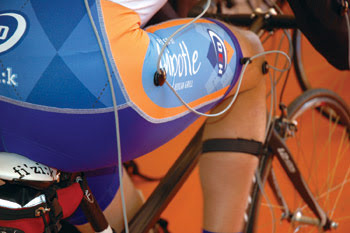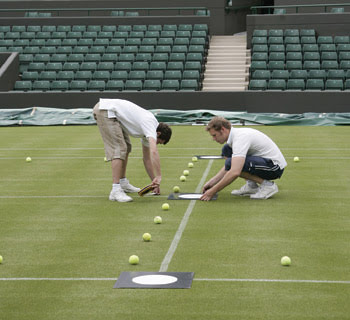Enhancing Athletic Achievement
Lighting, specialized optics and other technologies that can be labeled “protophotonics” were being used in sporting contests long before night games were played at Wrigley Field, but bright lights and television cameras have become old standbys, and more novel photonics equipment is making athletes stronger and competitions more lively.
Laughing at the wind
When a sailor sets out to sea, for a race or for leisure, she keeps a sharp eye on the wind – its bearing and its force. She knows that her task will be either easy or tough, depending on whether the wind is her friend that day. Weather forecasts and wind gauges at the marina provide her with general information about the wind, but on the ocean or on any large lake or other body of water, the wind can swirl and dance. Speeding along to the southeast at 10 knots in one spot, a stiff wind can then droop to a pokey 1 to 2 knots of northerly breeze just a hundred yards away.
How the wind blows across the surface of the open water is not only a concern of sailors – meteorologists would like to better predict high-shear-force winds and tornadolike microbursts that endanger aircraft, for example. In any case, there is much the interplay of air and water that interests Zhi-Shen Liu, a professor at Ocean University of China in Qingdao. Since the 1990s, Liu and his colleagues have been developing a Doppler-based lidar system to study how the atmosphere and the ocean surface interact.

Researchers at Ocean University of China have developed a portable Doppler lidar system that helps sailors judge wind currents with higher precision than previously possible. The complete system is installed in a van, inset, that can be brought to various harbors. The Doppler lidar system scans the sky at up to 10° per second, at an altitude of up to 10 m. Courtesy of Zhi-Shen Liu.
Imaging clouds in motion and training radar dishes on the skies can provide some wind data, but these techniques are limited when it comes to studying air currents in better weather. “Microwave radar can only observe the wind in cloudy weather, but cannot do anything on a clear day,” Liu said. “The better the atmospheric visibility, the higher the [Doppler] lidar’s performance.”
The Doppler lidar system devised by Liu’s team uses a 532-nm diode-pumped Nd:YAG laser set to scan a wedge of sky at up to 10° per second. At a rate of 2.8 kHz, the pulses spread out across the sea surface, reflecting back when they strike airborne particles. The reflections are captured by a 305-mm Schmidt-Cassegrain telescope connected via optical fiber to a nonpolarizing beamsplitter that sends one signal to a photomultiplier tube and the other through an iodine filter to a second photon counter. The filter was used to separate the Doppler-shifted signal from backscattered light.
Deviations between the original 532-nm output and the wavelength of the returned signal provide the Doppler information that gives wind speed and direction at every point in the swath cut by the lidar’s beams.
To boost the sensitivity of the system, the researchers used laser pulses in single-longitudinal mode, which they accomplished by minimizing the pulse buildup time via seeding the Nd:YAG laser with a continuous-wave laser. As reported in the July 1, 2008, issue of Optics Letters, they obtained real-time wind data with a horizontal resolution of 50 to 100 m and a temporal resolution of 2 to 10 min. According to Liu, this resolution is sufficiently high for many applications.
The team installed the Doppler lidar system in a van for mobility and has tested it at sailing regattas near the campus. Most recently, group members supplied real-time data for the Olympic sailing events, which were held at the Qingdao International Marina. International rules prohibit giving data directly to the competitors, but the information was provided to the national weather administration and then passed on equitably to all sailing teams.
Liu said that, although happy with the lidar system’s performance at the Olympics, he and his colleagues want to shrink and automate it. They also believe that it could be used in other sports affected by changing winds. In archery, for example, air currents can affect an arrow’s flight from bow to target, even when the archer is shooting in an indoor range.
For the landlubbers
If prowling the open seas isn’t your cup of bilge water, then perhaps you have joined the swarms of people who have adopted cycling as a major means of locomotion for recreation, for commuting to work or for doing errands close to home.
High fuel costs and an increasing desire to reduce one’s “carbon footprint” are effective inspiration for climbing onto an old Schwinn Sting-Ray and heading down the back roads and bike trails to the office. But the general public’s interest in cycling over the years has waxed and waned because most people don’t have their bikes tuned properly, and an imperfect fit always leads to stressed joints, aching muscles and an unnecessary level of fatigue – all of which conspire to drive people away from cycling after a relatively short time.
On the other end of the scale, professional cyclists, from trail riders and BMXers to road racers and triathletes, make certain to visit a qualified fitter frequently. Minute changes in the horizontal and vertical position – as well as in the angles between the knees, elbows, legs, arms and hips with respect to the saddle, the pedals and the handlebars – have large effects on performance and ride comfort.
Traditionally, a bike fitter would sit a client on his or her cycle and measure positions with plumb bobs and tape measures. Not very precise, the technique also fails at telling the fitter what conditions are like when the cyclist is actually pedaling.
More recently, fitting cyclists has involved placing small reflectors on the rider’s body – typically at the knee, shoulder, hip, wrist, etc. – and recording metrics while he or she cycles on a fluid trainer, a stationary bike stand that allows pedaling in place. The trouble is that, in most places where fittings take place, such as retail shops, ambient light and stray reflections from clothes, shoes and the bikes themselves can adversely affect readings.
At Retül in Boulder, Colo., Franko Vatterott and his colleagues have addressed the problems of passive fitting systems by using a motion-capture video system based on infrared LEDs.
“LEDs make the most sense for this application because of the typical bike-fitter environment,” said Vatterott, a co-founder (with inventor Cliff Simms) of the company. “We routinely see <0.3-mm accuracy, but since bicycles will generally flex about 1 mm, we use ‘submillimeter accuracy’ on our literature because anything less is insignificant.”

Wearing an LED-enhanced harness, a member of the Garmin-Chipotle racing team is fitted with his tour-racing cycle. Courtesy of Franko Vatterott, Retül.
Cyclists wear a harness with eight LEDs that attach to prime spots on their bodies. Each LED flashes once every 2.1 ms (476 Hz), and the light is captured by a sensor placed on a nearby tripod. According to the company, the sensor triangulates the position of the LED in true 3-D space, tracking points across longitudinal, vertical and horizontal planes so that a full set of body measurements is acquired every 34 ms.
Although Retül was only established in November 2007, the company quickly has gained a following. Members of the US triathlon team used the Retül system as part of their preparation for qualifying for this year’s Summer Olympics, and members of the American Garmin-Chipotle professional cycling team used it to get ready for the Tour de France.
According to Vatterott, the company is considering enhancements to the system, including additional LED markers and the ability to record heart rate, oxygen usage and similar metrics.
Who needs umpires?
In a series of efforts designed to enhance a viewer’s experience watching sports on television, several companies have developed systems that show, for example, whether a pitch was a ball or a strike, or where the puck is on the ice. These systems are based on images taken from TV cameras already in place in the ballpark or arena. Over the past few years, however, Hawk-Eye Innovations Ltd. of Winchester, UK, has fine-tuned the basic premise of camera-based ball tracking to the point where it is being used to help judges at events as prestigious as the Wimbledon tennis championships.
Developed by Paul Hawkins and his colleagues at Roke Manor Research Ltd., the system uses six to 10 proprietary cameras set around a venue. The Hawk-Eye system, as it is called, was designed originally to aid line calls in tennis. The cameras track the path of a ball in flight with about 99.9 percent accuracy, showing with the precision of a few millimeters where a ball has landed. The system also can be used by coaches and commentators to predict where balls might land if unimpeded.
The system has undergone some improvements since it was introduced in 2001, and it was officially sanctioned for use during a professional tournament in 2006, but the main challenge has been winning converts. It has, however, become widely used in several tennis championships, including Wimbledon, and the company has gone on to introduce the technology for other sports, including cricket, snooker and, to the surprise of traditionalists, football/soccer.

At Wimbledon’s All England Lawn Tennis Club in London, technicians prepare the tennis court for calibration of the video-based line-call system by Hawk-Eye Innovations, which allows for electronic views of close calls. AP Photo/Sang Tan.
Imaging technology is making a slow march toward respectability. Back in the US, major league baseball umpires only recently approved the use of video replay to review controversial home run calls. Again, decisions will be based on images supplied by whichever cameras are present; thus, nationally broadcast games, which tend to have more than the normal number of cameras, will have the best selection of angles from which to view balls heading for the fences. Eventually, one may see stadiums lined with cameras – or smaller sensors – poised to detect the exact moment a ball clears the outfield wall, passes through the uprights or enters the goal mouth.